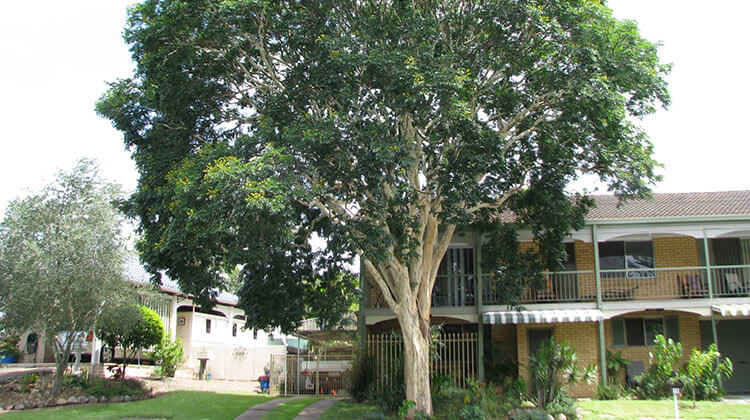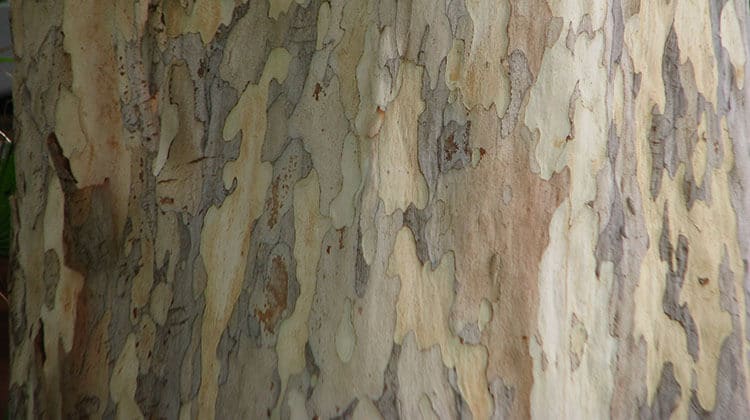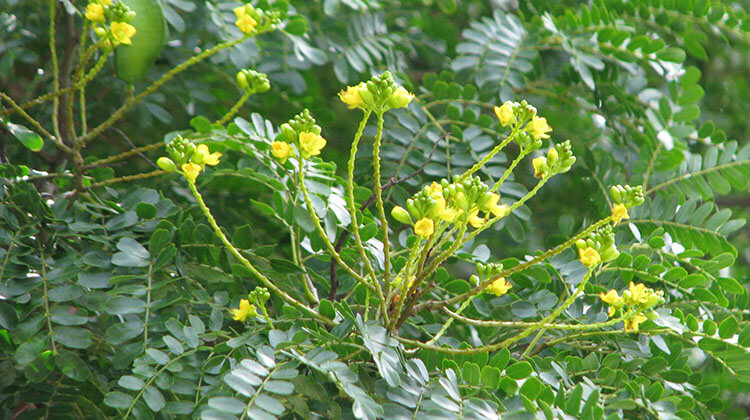Libidibia ferrea
formerly Caesalpinia ferrea
Family: Fabaceae Origin: Native to Brazil and Bolivia, South America
A large, semi-deciduous tree, the Leopard Tree can be pruned to a size suitable for suburban streets. This feature, its ornamental floral and autumn leaf display plus its hardiness in drought and frost conditions have seen the tree used by many Queensland councils and landscapers.
In recent times
The wood from Leopard Trees can present as an instant allergen to a number of people who have previously been unexposed. Despite this, it is a widely used in flooring, furniture manufacturing and to make gun grips. Its particular tonal qualities also mean that the trees’ timber is ideal for use in guitars.
Growth form
Typically cropped to 10-12 metres or less for suburban plantings, the trees can get to 20 metres tall when left to grow. With age, the trees’ canopy becomes dense and their trunk thickens. The branches spread to 6-8 metres.
Arboriculture
Trunk
The tree sheds its bark leaving a distinctive, grey and white dappled effect across the trunk. The pattern is reminiscent of leopard-print, hence the trees’ unique name.
Flowering
Spikes of bright yellow flowers are produced at the ends of stems on the tree, the colour further reinforcing the trees’ commonly derived name. These panicles can become messy when falling and do attract birds, bees and butterflies to the tree.
Foliage
Leopard trees have delicate, layered foliage with very small acacia-like leaves.
Growing in compound formation, the leaflets average 2.5 cm in length although when used in bonsai, the leaves can be stunted to as little as 1.5 cm each.
They foliage is dark green until autumn when it drops in a spectacular display of raining red. Regrowth appears as a pinkish-red, later developing to its mature green.
Management
Propagation
Indehiscent, the hard seedpods of these trees will not break open without assistance. Once hammered apart, the seeds inside are relatively easy to germinate. They need to be scarified and soaked in water but afterwards will readily take to soil and sprout within days.
Propagation from cuttings is also possible when older wood is used in combination with dipping into a plant hormone.
Cultivation
Fast-growing if given fertile, well-drained soil and full-sun. The main consideration when cultivating these trees is to plant in open areas away from underground sewerage systems, pipes or beneath concrete where they will invade. As Brisbane arborists, we hear more complaints about leopard trees than any other tree.
Very hardy, Leopard Trees survive drought-conditions, cold tending to frost, root pruning and transplantation. The tree can also be clipped at a young age without causing any damage to its development.
An ongoing cleaning schedule is necessary to prevent the trees from becoming a problem. They will drop leaves all-year round with increases in autumn. Their flowers fall as well as their hard, black seed pods which can form a tripping hazard on paths and walkways or cause injury if left on the grass and flicked at high speeds when spat out by mower blades.




Hi David,
Is there a type of grass that will grow under a large leopard tree?
Well, What a mob of wingers complaining about Leopard Tree. You have little in ife to be saying all those stupid things about a Leopard Tree. Why do you just get your rake a couple of times per year and spend ten minutes just raking round your dreadful Leopard Tree. They are not a large tree and any lef drop makes wonderful mulch, you probably do not even know what mulch is nor what you use it for. I am sure that raking up the seed pods now and then will not damage your back either. You should feel blessed to have a lovely Leopard growing in your yard or on the footpath, There is just so many of you with that same attitude regarding trees, it just makes me feel ill when I see those types of comments. You must never think about our world without trees. God help us.
Did you actually read previous entries. We are actually very tree aware. And are trained horticulturists and have owned a nursery for many years.Have a quarter acre block without grass. We also maintain and plant trees regularly in our adjacent park. You have no idea as to what these trees do to pipes . Suggestion s that they are planted more than the root spread of Over 10 metres away from infrastructure.when they drop and invade roof space and fill gutters with leaves independent of gutter guards. Lift footpaths and get into sewer pipes. These trees as Brisbane Council knows are trouble. Laugh again at Newcastle council who has now planted 4 at the entrance of the rebuilding of the hunter st mall. Cm from footpaths and walkways. 🤭🤭
Please….as time goes on, we learn and in this case, that leopard trees need space to stop problems. Many trees have been planted in the wrong position and always will be.
Maybe if you reread your article you will understand why you got the comments that you did. Don’t deride the tree….just point out the issues and recommend a large area.
As far as the trip hazard….well I don’t know how I got to 77 and still be verticle…..but anyway that seems to be the way of it these days. Look where you are going and lift your dam feet.
I am sure I will get some derogatory comments as well.
Well Tom Bradley if You Think that A Leopard Tree Does NOT GROW VERY BIG, Then I Think You’re Touched in The Head !!!!!.. A 60 Plus FOOT at Guess is not a Small Tree whose branches are coming off in Storms, Seed Pods Constantly Dropping, and then there’s the bloody Billions of Leaves Clogging And Rotting Gutters and is 3 metres from a Water Hydrant. Raking up a Couple of times per Year?.., You Seriously Sure Are Touched in The Head, they drop housands CONSTANTLY And Then There’s The Flowers as well, Seed Pods Constantly As Well!.. They’re Only Great on a Property up the Back but Definitely NOT A SUBURBAN TREE TO PLANT AND HAVE BESIDE YOUR NEIGHBOURS Looming Over The House, SO if you Want too Come and Clean My Gutters and Fix My Roof Mate, Come on Over and You Can Go For Your Coit and go on The Neighbour’s Payroll Who Has this Said Pain in The Ass Tree and Clean My Roof! BECAUSE THEY WILL NOT… NEXT STOP, PRAYERS FOR BEING STRUCK BY AN ACT OF GOD…
Amen, when my leopard tree is dropping pods, I spend 5 minutes raking up the pods before I mow. It’s NOT a big deal and the tree is beautiful.
These trees 8 were planted along our footpath 25 years ago. We have consistently had to clean gutters. As we have tank water. The cement footpath has been repaired by council 4 times. The roots are now travelling under a 10 foot triple rowed brick wall 4’under ground level into our sewer. Council will do nothing . We are told we cannot poison the roots . They will not prune. These trees are a major problem tree. The seeds so large you skate and slip on the hard seed. Do not plant these trees anywhere near anything you value. Not appropriate for a council tree. At least Brisbane is smart. Newcastle is a stupid stupid council planting these still under wires
would it be an offence if you were to prune them after flowering so the pods do not form? Perhaps Council will only take action when the tree roots start lifting concrete footpaths or gutters? Raised up footpaths create a danger of liability for personal injury, so watch out for any near you or near other leopard trees, and notify them with photos.
Totally Totally Agree with Every Comment Debra, They’re not Smart Council North of Brisbane Either,,,
Are the seeds could of some benefit?
I live in a suburban street which is lined with leopard trees. They are very beautiful and the leafiness gives the street its great appeal. Birds such as lorikeets love to nest in them. Unfortunately, the trees are a menace and my council does not maintain them. The seed pods drop for about three months in spring and when dropping from their great height, can cause damage to vehicles. Since the tree overhangs my property, the pods crash on my carport, sounding like gunshots! When the pods get wet on my driveway they leave a tannin stain. The tiny leaves collect and mat on the roof, collecting under the solar panels and creating a fire hazard. When removed, the sticky sap lifts the paint from the roof. I have fine gutter guard but the leaves still collect on top in the gullies. I understand too that the roots search for openings in water pipes and drains and can interfere with concrete and underground electrical cables. A beautiful tree in an open paddock or its native habitat but in suburbia it is a deceitful saboteur. If councils were responsible with common sense, they would be banned and anyone planting them would be fined!
God what’s with Aussies constantly complaining? You’re worse than Brits
You have to live with the consequences of someone elses planting of a leopard tree before you even qualify to make comment on someone elses plight. Imagine if you will a 6 mm long hard thorn on the end of a hard woody seed pod . Designed by nature to drop vertically and penetrate the ground, instead dropping from 12 to o 15 metres and penetrating the relatively thin flesh of your head, without warning. Fun NOT.
Leopard trees are natives of Australia but of the inland wide open spaces, they have no place in suburbia as their root system is highly invasive of underground plumbing. All councils should have a recommended list of local indigenous plants and shrubs for planting to benefit the local birds and wildlife.
Any tree which endangers existing infrastructure should be trimmed to the point where it no longer does so.
I have several leopard trees lining the driveway of my new rural property and two of them have a full covering of rusty brown leaves. Some of the other trees have a sparse canopy whilst others are green and reasonably full. Are the rusty brown leaves indicative of disease or new growth?
Hey, I live in Sri Lanka and my husband has planted a root balled leopard tree in our indoor courtyard which is currently approximately 17 feet tall. When I did my research on the internet it was advised not to plant it near buildings. So, I am eager to know whether we are in trouble , or won’t there be any problem? Please help!!!
Hi David. I’ve read all of these comments with interest. I recently moved into a house in Bellbird Park which has a large leopard tree just inside our border. It’s a beautiful tree but I notice that some of the branches are beginning to interfere with the wires running to the house. I presume it is up to us to prune these but have no idea how to go about it and need advice. I’m not exactly sure of the distance to the house, but think it’s ok. The garden has been severely neglected and it’s quite a challenge to know where to start. I want to plant grass between the tree and the house where there is what appears to be a natural swale but am not sure whether that’s even a possibility. At present there is nothing but weeds. Can you help at all?
Catalogue of Life lists Caesalpinia ferrea as accepted and Libidibia a synonym.
Hi,
I’ve got a garden bed under my tree and the plants and rats around it isn’t doing so well. Is that because the leopard tree is taking all the nutrients? I’m thinking of cutting it down and grinding the stump. Will that help restore me plants?
Thanks
Hi David
We recently moved into a retirement village where there are a number of leopard trees. Our body corporate advised they were going to have them pruned back 30% of the canopy for safety reasons due to the falling seed pods. However, to our dismay they have pruned all of the trees back by 30% leaving just the bare trunk and branches but no foliage at all. Do you think this is appropriate and will the trees survive such a severe pruning? How long do you think it will take them to recover?
Hi David,
Our neighbour has a leopard tree approx 1 mtre from our boundary fence which as you know drops so much crap and is growing on and over a private power line which runs through our property which services the back neighbour (another issue) We have asked the neighbour to prune the out of reach branches to fence line but still waiting for a response.. Also we have just restumped our property and are a bit concerned about its root system stuffing up our new brick piers.. Would like to have the neighbour remove more than trim back.. I have spoke to QCAT but find it ridiculous that we have to pay a fee of more than $350+ to apply to have removed.. Not to mention the Jackaranda and 4 humongous prob 60-80 ft or more some sort of pine trees that also are so close to the fence boundary.. Don’t get me wrong I love trees but not where these ones are.. Do you have any advice to help us out please would be much appreciated
Regards Dal
write letters to neighbour, politely requesting they remove of the offending trees. Give the detailed reasons they should be removed, eg. leopard tree trunk is x metres from underground private powerline running thro yr property to service the neighbour ‘behind’ you. Also express your concern about the possible negative impact of their leopard tree on your recent restumping project. etc
Write in upper case at top of the letter WITH PREJUDICE. Keep a copy.
You could send the letter by Registered Post, but before sending prepare a Stat. Dec. and copy, and get a JP at the post office to sight the letter, the copy and you placing the letter into envelope and handing it across for posting. The Stat Dec should give the number of the Registered Post envelope, and describe the above sightings and refer to the copy as the document marked ‘A’. Also the copy of the letter should have the words: “This is a copy of the document marked ‘A’ being a copy of the letter referred to in the Stat. Dec signed by me on [date].
Can you phone or visit a Community Legal Centre for advice?
Keep copies of everything incl receipt for Registered Post and ask your neighbour behind to write a similar letter regarding the powerline.
Hello. I have 13 yr old leopard tree in front yard for sun protection. Have a western face house. Can u tell me the best way to prune. My concern is cyclones.. can I trim one side one year then other side following year. I want to keep the hight for house shade but reduce the
amount of foliage. Is it best practice to trim both sides at same time. It’s a beautiful tree keeping my garden cool and don’t want to remove it. Cheers
What diseases can affect the Leopard tree. I live in Hampton Queensland and there are times when my Leopard tree has hardly any leaves. This is even in the full growing period in summer. Just when I think I should remove it burst into leave.
We have just had a landscape plan done by a landscape designer and he has suggested a leopard tree (over a maple tree) for our open roof internal garden.
I was hoping to contain it to about 8-10 metres in height. Is this even possible?
Also, after reading all these posts, I’m now concerned about the invasive nature of the roots – can the roots be contained successfully with the aid of a root barrier and if so what would be a recommended width and depth?
Should be still consider a leopard tree or still to a maple tree?
Thanks in advance.
dont plant so much trouble
I hope for your sake you chose the maple. If not its not to late dig it up and plant it at your landscapers
Apparently there is a native Leopard Tree too. Maybe worth looking up.
I have a large leopard tree in my yard but I just can’t cope with the year long debris. mid-year seed pods and tannin everywhere, November drops it’s entire canopy then grows it straight back (what’s that about?) then I think autumn yellow flower pentals every where.. About 15 m tall. How do I kill it first? Too close to the wall to grind out & can’t afford the arborist at this stage
Hi David,
Are the seeds and pods poisonous to sheep and goats?
Hi David,
Can you please tell me do the seed pods drop all year round?
Cheers